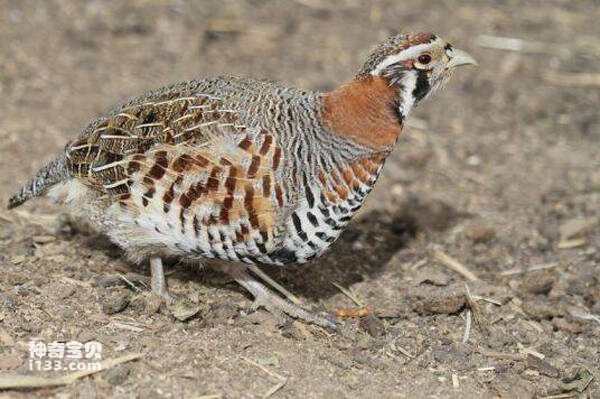Tibetan Partridge
IUCN
LCBasic Information
Scientific classification
- name:Tibetan Partridge
- Scientific Name:Tibetan Partridge,Perdix hodgsoniae
- Outline:Landfowl
- Family:Chickeniformes P.family Partridge
Vital signs
- length:23-32cm
- Weight:270-550g
- lifetime:No textual research information is available
Feature
It has a striking white brow line and a characteristic maroon collar, with black spots on the side of the face under the eyes
Distribution and Habitat
It is found in Bhutan, China, India and Nepal. The Tibetan subspecies is found in western and southern Tibet. Named subspecies in southeast Tibet; The Sichuan subspecies is found in eastern Tibet, northwestern Sichuan, southern Qinghai and Gansu, and the Qinghai subspecies is found in northern Qinghai.
It inhabits alpine bare rock, alpine tundra plateaus and subalpine scrub and scrub areas between 2500 and 5000 m above sea level, with seasonal vertical migration, and rocky foothills of sparsely grown gorse, scrub, juniper and heath that can descend to about 2500 to 3000 m in winter. In the gentle slopes and scrub areas in front of the mountains, some grassy slopes on the edge of the cultivated land are more visible.
Appearance
Male highland partridge adult bird head chestnut purple, mixed with black; Black pillow and nape, mixed with brown and white plumage and stripes; There is a narrow black spot on the frontal basal. The stripes of the eyes from the forehead to the back of the neck, as well as the eyes and cheeks, are brown-white. The underside has a short black stripe; There is a black patch under the eye, about 10 mm wide and 15 mm long, extending down to the throat, and its upper end is connected with the dark brown ear; Red patches with fine brown lines; Ear feathers with white plumage; The nape has a brown semi-annular band (about 15 mm at widest point). Brown and white covering from back to tail, with arranged dark brown markings; The central tail feathers are slightly the same; However, the black spots are thicker, and the brown and white parts are also mixed with intermittent black markings; Outer caudal chestnut, sometimes blackened; The third class of shoulder and wing overlying feathers are bro
Details
Alpine Partridge (Perdix hodgsoniae) is a Tibetan Partridge with four subspecies.

Highland partridge is a common resident bird. In addition to the breeding period, it is usually active in groups of 10-15 birds. Up to more than 30, do not like to fly, good at running, running quickly on the ground and in the bush, even when frightened, do not take off, but run quickly on the ground, cry quickly scattered, in the running over the species, sometimes stay and watch, when driven more than three or three spread out to the safety of the mountain. When fleeing into grass, brush or crop fields, and then hiding, wait for a while, the parent bird will make a call, such as calling young birds together. Fly only when you have to. Take off is more flexible, fly quickly, but also glide, especially when going down the mountain mainly through gliding, generally do not run down the mountain.
Alpine partridge feeds mainly on leaves, buds, stems, berries, seeds, grass seeds, moss, etc. of alpine plants and shrubs, and likes to eat fresh food. They also eat animal foods such as insects. Loud calls such as scherrrrrreck-scherrrrreck. chee, chee, chee, chee, chee, chee.

The alpine partridge begins to sing and show courtship behavior between March and April. The call is mostly early in the morning and at dusk. The call is like "da ka, da ka", and they often make a "chirp" sound when calling each other. After pairing, they leave the group and occupy the area to nest. Nesting is rich in brush and wormwood plain gully, stream, dry grassland, grassland young forest and mountain sparse forest, thicket area. The nest is mostly placed on the ground in tall grass or under brush, with shrubs and grass hiding, generally difficult to find. Male and female birds often nest together. The structure of the nest is very simple, mainly in the soft ground hollow dug a shallow pit, padded with hay, moss and feathers. Each clutch lays 8-12 eggs, with a maximum of 15 eggs. The eggs are pale yellow or olive in color and are 35-43 x 24-27 mm in size. Incubation is shared between male and female birds, or the female incubates the eggs and the male guards the nest area. Female birds have a strong nest love. Chicks can follow their parents the same day they hatch.
Compared with other partridge, highland partridge is less affected by human beings, so it still has a high density in local areas of Tibetan plateau, but the total number is not too much due to the limitation of alpine environmental conditions, and the hunting should be controlled and attention should be paid to protection.
On April 17, 2022, photographer Wu Wei took this photo of "green-backed" highland partridge feeding in the hinterland of Sunan Yugur Autonomous County in Zhangye, Gansu province.
It was included in the List of Beneficial Terrestrial Wildlife under State Protection or of Important economic and scientific research Value issued by the State Forestry Administration of China on August 1, 2000.
Listed on the International Union for Conservation of Nature (IUCN) 2013 Red List of Threatened Species ver3.1 - Not Threatened (LC).
Protect wild animals and eliminate wild meat.
Maintaining ecological balance is everyone's responsibility!








